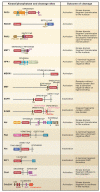Caspases and kinases in a death grip
- PMID: 19737514
- PMCID: PMC3390419
- DOI: 10.1016/j.cell.2009.08.021
Caspases and kinases in a death grip
Abstract
The complex process of apoptosis is orchestrated by caspases, a family of cysteine proteases with unique substrate specificities. Accumulating evidence suggests that cell death pathways are finely tuned by multiple signaling events, including direct phosphorylation of caspases, whereas kinases are often substrates of active caspases. Importantly, caspase-mediated cleavage of kinases can terminate prosurvival signaling or generate proapoptotic peptide fragments that help to execute the death program and facilitate packaging of the dying cells. Here, we review caspases as kinase substrates and kinases as caspase substrates and discuss how the balance between cell survival and cell death can be shifted through crosstalk between these two enzyme families.
Figures




Similar articles
-
Kinases leave their mark on caspase substrates.Biochem J. 2021 Sep 17;478(17):3179-3184. doi: 10.1042/BCJ20210399. Biochem J. 2021. PMID: 34492095
-
Involvement of Asp-Glu-Val-Asp-directed, caspase-mediated mitogen-activated protein kinase kinase 1 Cleavage, c-Jun N-terminal kinase activation, and subsequent Bcl-2 phosphorylation for paclitaxel-induced apoptosis in HL-60 cells.Mol Pharmacol. 2001 Feb;59(2):254-62. doi: 10.1124/mol.59.2.254. Mol Pharmacol. 2001. PMID: 11160861
-
Inflammatory caspase substrate specificities.mBio. 2024 Jul 17;15(7):e0297523. doi: 10.1128/mbio.02975-23. Epub 2024 Jun 5. mBio. 2024. PMID: 38837391 Free PMC article. Review.
-
Regulation of cell proliferation and survival: convergence of protein kinases and caspases.Biochim Biophys Acta. 2010 Mar;1804(3):505-10. doi: 10.1016/j.bbapap.2009.11.001. Epub 2009 Nov 10. Biochim Biophys Acta. 2010. PMID: 19900592 Review.
-
Constitutive caspase activation and impaired death-inducing signaling complex formation in CD95-resistant, long-term activated, antigen-specific T cells.J Immunol. 2003 Aug 1;171(3):1172-82. doi: 10.4049/jimmunol.171.3.1172. J Immunol. 2003. PMID: 12874203
Cited by
-
Quercetin induces human colon cancer cells apoptosis by inhibiting the nuclear factor-kappa B Pathway.Pharmacogn Mag. 2015 Apr-Jun;11(42):404-9. doi: 10.4103/0973-1296.153096. Pharmacogn Mag. 2015. PMID: 25829782 Free PMC article.
-
The DegraBase: a database of proteolysis in healthy and apoptotic human cells.Mol Cell Proteomics. 2013 Mar;12(3):813-24. doi: 10.1074/mcp.O112.024372. Epub 2012 Dec 20. Mol Cell Proteomics. 2013. PMID: 23264352 Free PMC article.
-
p27Kip1 Is Required to Mediate a G1 Cell Cycle Arrest Downstream of ATM following Genotoxic Stress.PLoS One. 2016 Sep 9;11(9):e0162806. doi: 10.1371/journal.pone.0162806. eCollection 2016. PLoS One. 2016. PMID: 27611996 Free PMC article.
-
Use of the guinea pig in studies on the development and prevention of acquired sensorineural hearing loss, with an emphasis on noise.J Acoust Soc Am. 2019 Nov;146(5):3743. doi: 10.1121/1.5132711. J Acoust Soc Am. 2019. PMID: 31795705 Free PMC article. Review.
-
Characterization of caspase-2 inhibitors based on specific sites of caspase-2-mediated proteolysis.Arch Pharm (Weinheim). 2022 Sep;355(9):e2200095. doi: 10.1002/ardp.202200095. Epub 2022 May 31. Arch Pharm (Weinheim). 2022. PMID: 35642311 Free PMC article.
References
-
- Allan LA, Clarke PR. Phosphorylation of caspase-9 by CDK1/cyclin B1 protects mitotic cells against apoptosis. Mol. Cell. 2007;26:301–310. - PubMed
-
- Allan LA, Morrice N, Brady S, Magee G, Pathak S, Clarke PR. Inhibition of caspase-9 through phosphorylation at Thr 125 by ERK MAPK. Nat. Cell Biol. 2003;5:647–654. - PubMed
-
- Arnold R, Liou J, Drexler HC, Weiss A, Kiefer F. Caspase-mediated cleavage of hematopoietic progenitor kinase 1 (HPK1) converts an activator of NFκB into an inhibitor of NFκB. J. Biol. Chem. 2001;276:14675–14684. - PubMed
-
- Arnold R, Frey CR, Müller W, Brenner D, Krammer PH, Kiefer F. Sustained JNK signaling by proteolytically processed HPK1 mediates IL-3 independent survival during monocytic differentiation. Cell Death Differ. 2007;14:568–575. - PubMed
-
- Alvarado-Kristensson M, Andersson T. Protein phosphatase 2A regulates apoptosis in neutrophils by dephosphorylating both p38 MAPK and its substrate caspase 3. J. Biol. Chem. 2005;280:6238–6244. - PubMed
Publication types
MeSH terms
Substances
Grants and funding
LinkOut - more resources
Full Text Sources
Other Literature Sources

